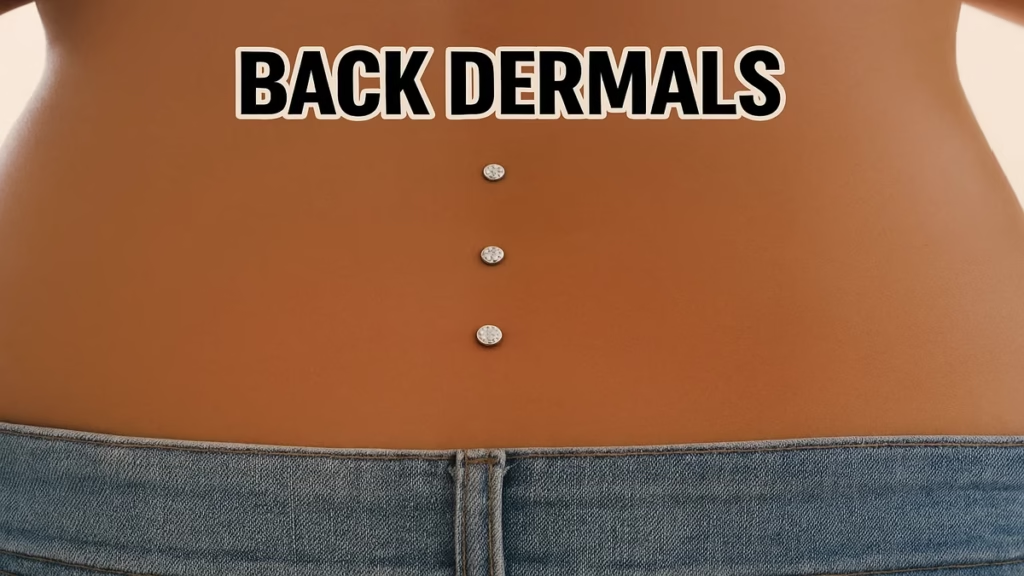Introduction
Body modifications have always been a form of self-expression, and among the most stylish yet unique ones are back dermals. Unlike traditional piercings, dermals sit flat against the skin, creating a striking and aesthetic appearance. Whether you want a single subtle jewel on your lower back or a row of decorative dermals running down your spine, this type of piercing is becoming increasingly popular.
In this detailed guide, we’ll cover everything you need to know about back dermals—from the procedure, aftercare, pros and cons, to removal options. By the end, you’ll know if this body mod trend is the right choice for you.
What Are Back Dermals?
Back dermals, also known as dermal piercings or microdermals, are a type of single-point surface piercing. Unlike traditional piercings that have an entry and exit point, dermals are anchored into the skin using a small titanium base.
- Anchor Base: A small flat implant placed under the skin.
- Visible Top: A decorative jewel or flat stud that remains visible on the surface.
They can be placed anywhere on the body, but back dermals are especially popular for creating symmetrical designs or spine-aligned jewelry aesthetics.
Why Choose Back Dermals?
Back dermals are appealing for several reasons:
- Unique Aesthetic – They stand out compared to traditional piercings.
- Customizable Designs – You can align multiple dermals down the spine for a dramatic effect.
- No Exit Hole – Unlike regular piercings, dermals look like they “float” on the skin.
- Fashion Statement – Often seen in festivals, fashion shoots, and tattoo culture.
How Are Back Dermals Done?
The procedure for getting back dermals requires precision and professional expertise. Here’s a step-by-step breakdown:
1. Consultation
- Discuss placement options and jewelry styles with your piercer.
- Review health conditions or skin issues that may affect healing.
2. Skin Preparation
- The piercer sterilizes the area to reduce infection risk.
3. Anchor Insertion
There are two main techniques:
- Dermal Punch Method: A small hole is punched in the skin for the anchor.
- Needle Method: A needle creates a pocket where the anchor is inserted.
4. Jewelry Placement
- A decorative top is screwed onto the anchor.
⏱ Time: The process usually takes 15–30 minutes per dermal.
Pain Level: Do Back Dermals Hurt?
Pain levels vary depending on your tolerance. Most people describe it as:
- A sharp pinch when the skin is punctured.
- A bit of pressure during anchor insertion.
- Mild soreness for a few days afterward.
💡 Tip: Areas with less fat and more muscle (like the spine) may feel more painful compared to fleshy areas.
Healing Time for Back Dermals
Healing times for back dermals can take anywhere from 1 to 3 months.
- Initial Healing: 2–3 weeks (surface swelling reduces).
- Full Healing: 8–12 weeks.
During this time, it’s important to avoid friction from clothing, backpacks, or bedding.
Aftercare Tips for Back Dermals
Proper aftercare ensures long-lasting results and prevents rejection or infection.
Daily Care:
✔ Clean twice a day with saline solution.
✔ Pat dry with a paper towel (avoid cloth towels).
✔ Keep hair, lotions, and perfumes away from the area.
Things to Avoid:
❌ Tight clothing rubbing against dermals.
❌ Sleeping directly on your back.
❌ Touching or twisting the jewelry.
❌ Swimming in pools, hot tubs, or lakes until fully healed.
💡 Pro Tip: Using breathable bandages for the first few nights can protect new dermals from snagging.
Risks and Complications of Back Dermals
While stylish, back dermals come with certain risks.
- Infection – Due to bacteria entering the wound.
- Rejection – The body may push out the jewelry over time.
- Scarring – If dermals are removed incorrectly.
- Snagging – Clothing or straps may catch, causing irritation.
According to Healthline, dermal piercings are more prone to complications compared to traditional piercings, making professional aftercare guidance crucial.
How Long Do Back Dermals Last?
On average, back dermals last 1–3 years depending on placement and care. Some may last longer, while others may be rejected within months.
Factors that affect longevity:
- Placement (high-friction areas reject faster).
- Aftercare routine.
- Skin type and healing response.
Cost of Back Dermals
The price varies based on studio reputation and jewelry quality.
| Factor | Average Price (USD) |
|---|---|
| Single Dermal | $70 – $100 |
| Multiple Dermals (Spine) | $200 – $500 |
| Jewelry Upgrades | $20 – $100+ |
💡 Always prioritize professional studios with sterilization practices, even if the cost is higher.
Removal of Back Dermals
If you no longer want your dermal, professional removal is required.
Removal Process:
- A piercer or dermatologist numbs the area.
- A small incision is made to remove the anchor.
- The skin is cleaned and bandaged.
⚠️ Never attempt removal at home, as it may cause deep scars or infections.
Back Dermals vs. Traditional Piercings
| Feature | Back Dermals | Traditional Piercings |
|---|---|---|
| Entry/Exit Points | Single point | Two points |
| Healing Time | 1–3 months | 6–8 weeks |
| Risk of Rejection | Higher | Lower |
| Jewelry Style | Floating appearance | Visible bar/ring |
| Longevity | 1–3 years | Permanent (if maintained) |
Popular Jewelry Styles for Back Dermals
- Gemstone Tops – Sparkly crystals for a glamorous look.
- Flat Discs – Minimalist and subtle.
- Opal Studs – Trendy and colorful.
- Themed Designs – Stars, hearts, and custom shapes.
Many choose to align several dermals down the spine for a “chandelier effect.”
Are Back Dermals Worth It?
If you love unique, eye-catching piercings and are willing to commit to aftercare, back dermals can be worth it. They allow for creative expression and stand out as body art. However, consider the risks of rejection and potential scarring before making a decision.
FAQs on Back Dermals
1. Do back dermals leave scars after removal?
Yes, small scars may remain, but they fade over time with proper skin care.
2. Can I work out with back dermals?
Yes, but avoid exercises that put pressure on your back until fully healed.
3. Are back dermals permanent?
They’re semi-permanent, lasting a few years depending on care and placement.
4. What happens if a dermal gets infected?
Seek professional help immediately. Avoid removing jewelry yourself.
Conclusion
Back dermals are a bold and stylish body modification trend, offering endless customization and unique aesthetic appeal. While they require careful aftercare and carry some risks, many find them to be a beautiful form of self-expression.
If you’re considering getting back dermals, always choose a licensed piercer, follow aftercare instructions, and weigh the pros and cons.
👉 For more lifestyle, health, and fashion insights, explore Blog Adviser.







